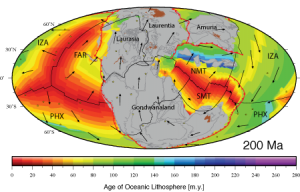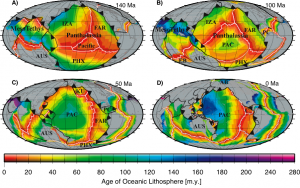 Global plate motion models provide a spatial and temporal framework for geological data and have been effective tools for exploring processes occurring at the earth’s surface. However, published models either have insufficient temporal coverage or fail to treat tectonic plates in a self-consistent manner. They usually consider the motions of selected features attached to tectonic plates, such as continents, but generally do not explicitly account for the continuous evolution of plate boundaries through time. … Read more…
Global plate motion models provide a spatial and temporal framework for geological data and have been effective tools for exploring processes occurring at the earth’s surface. However, published models either have insufficient temporal coverage or fail to treat tectonic plates in a self-consistent manner. They usually consider the motions of selected features attached to tectonic plates, such as continents, but generally do not explicitly account for the continuous evolution of plate boundaries through time. … Read more…
Plate reconstruction with paleo-bathymetry of the ocean basins
Reconstructions of tectonic plates and oceanic paleodepth (i.e. paleobathymetry).Citation Müller, R., M. Sdrolias, C. Gaina, and W. Roest (2008). Age, spreading rates, and spreading asymmetry of the world’s ocean crust, Geochemistry, Geophysics, Geosystems, 9(4), 19, Q04006. doi: 10.1029/2007GC001743.View the full playlist on our EarthByte YouTube channel

